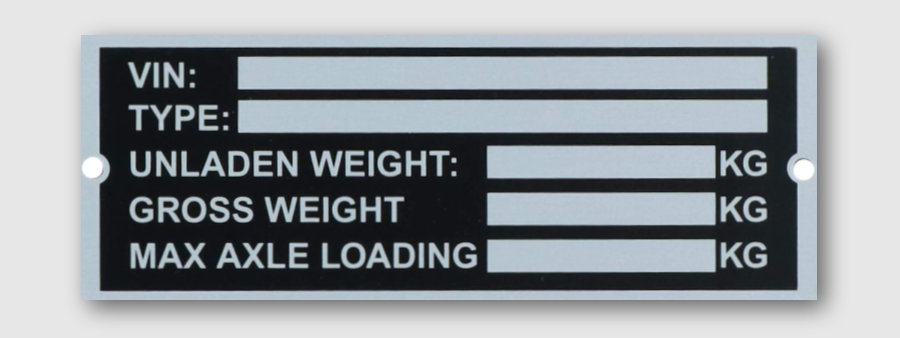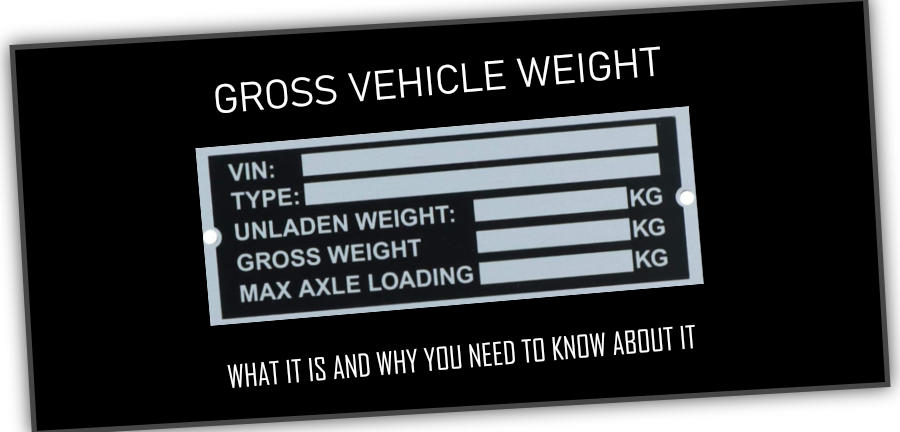So, gross vehicle weight (GVW), what it is, and why it is absolutely critical that you, as a driver, know everything there is to know about it.
Gross Vehicle Weight is the maximum weight a vehicle is allowed to weigh when fully loaded with goods, passengers, & fuel. Every motor vehicle has a plated Gross Vehicle Weight which can be found on your vehicle’s VIN plate. GVW can be in excess of 1360kg for motorcycles, 1920kg for cars and up to 3500kg for vans.
GVW is the weight your car, van, or any other motor vehicle you operate, must never exceed. If you exceed the plated GVW of your vehicle, you’re effectively overloading which carries fixed penalty fines and, depending on the severity of the offence, a possible court summons.
What Does GVW Mean?
GVW is an abbreviation of Gross Vehicle Weight and refers to the maximum weight a motor vehicle must not exceed. Different vehicle types have different GVW depending on their design and purpose.
For instance, a motorcycle is designed to carry 2 passengers and some cargo so its GVW (maximum permissible load weight) will be much lower than, let’s say, a Luton van.
A Luton van is a light commercial vehicle designed primarily to carry goods and cargo so has a much higher GVW. The weight of any passengers in this vehicle type is, at best, an afterthought.
What Is Gross Vehicle Weight?
GVW is the value, in kgs, you reach by adding together the kerb weight of a vehicle and its payload capacity, the amount in kgs you’re allowed to carry.
Kerb (empty) Weight + Payload Capacity = GVW (Gross Vehicle Weight)
Points to note:
- Kerb weight is the weight of a car, van, or any other motor vehicle, including trailers, as it stands without goods or passengers.
- Payload capacity is how much, in kgs, you’re allowed to load your vehicle before it becomes overloaded.
- You can find your vehicle’s kerb weight, payload weight and GVW on its VIN plate.
Here are some examples of common vehicle types and their weight classes.
| Vehicle | Type | Kerb Weight | Payload | GVW |
|---|---|---|---|---|
| Harley Davidson Dyna (Street Bob) | Motorcycle | 302kg | 190kg | 492kg |
| Ford Focus (2.0L TDCi) | Car | 1462kg | 588kg | 2050kg |
| Nissan NV400 (3.5t) | Van | 1934kg | 1566kg | 3500kg |
| Ford Transit (350 L2 H2) | Minibus | 2574kg | 926kg | 3500kg |
| Ifor Williams (LT85) | Trailer | 450kg | 1550kg | 2000kg |
Always refer to the VIN plate on the vehicle you’re operating. It will specify kerb weight and, most likely, payload capacity as well as GVW for that specific vehicle.
If the VIN plate doesn’t specify payload capacity, you can work it out by simply subtracting kerb weight from GVW. It’s worth noting that a VIN plate may refer to kerb weight as “unladen weight”.
Does GVW Include Passengers & Fuel?
Yes, GVW does include passengers and fuel. In fact, it includes the weight of anything loaded onto a vehicle while it is in operation as well as the weight of the vehicle itself.
Everything from cargo, fuel, & passengers to any other weight the vehicle is burdened by adds up to meet the vehicle’s maximum permissible load weight.
GVW is an uncompromising value too as it is the only weight specification that absolutely doesn’t change. Whereas a lower kerb weight means higher payload capacity and vice versa, GVW will remain constant to your vehicle type. The value of which is always kerb weight + payload capacity and should never be exceeded.
What you load into your car or van is irrelevant, the only thing that is taken into account is how heavy that burden is and if it exceeds GVW to the point of overloading.
How To Find The Gross Vehicle Weight Of My Van?
You can find the gross vehicle weight for your car, van, whatever, by checking your VIN plate.

It will look much like the image above and will be located in one of the following places.
- On the inner door well on the driver’s side of your vehicle.
- In the engine bay fixed to the chassis.
- On the dashboard.
This will tell you everything you need to know about your vehicle type and weight limitations. If you have trouble finding your VIN plate, check your owner’s manual or, like most curious people, do it the easy way and Google it.
Difference Between Gross Vehicle Weight (GVW) and Maximum Authorised Mass (MAM)
There is no difference between MAM (Maximum Authorised Mass) and GVW (Gross Vehicle Weight) as they are, in fact, one and the same.
But why do we need 3 different terms to explain a single weight value? And yes, I said 3.
Well, to confuse matters further, MAM and GVW are also officially recognised as PMW (Permissible Maximum Weight) – yet another legal definition of the aforementioned 2. How this came to be is anyone’s guess, but, it is what it is and we must come to terms with it.
Maximum authorised mass (MAM) means the weight of a vehicle or trailer including the maximum load that can be carried safely when it’s being used on the road.
This is also known as gross vehicle weight (GVW) or permissible maximum weight.
From GOV.UK
Out of the 3, GVW is certainly the more commonly referenced term but MAM, GVW, or PMW, can be used to effectively describe the same thing – the maximum permitted mass of a motor vehicle when fully loaded.
What Happens If I Exceed The GVW Of My Van?
Exceeding the GVW of your van, car, or whatever motor vehicle you’re operating will result in one of 4 bothersome consequences.
| Overweight By | Fine (Fixed Penalty) |
|---|---|
| 5% – 9.99% | £100 |
| 10% – 14.99% | £200 |
| 15% – 29.99% | £300 |
| 30% & Over | Court Summons |
Points to note:
- Any motor vehicle can be overloaded.
- Overloading occurs when a vehicle weighs more than its plated GVW.
- Penalties reflect the severity of the offence.
- Extreme violations can result in a driving ban.
We actually did a full article on vehicle overloading and penalties for exceeding your MAM (yes, let’s use that term at least once) weight. You can read that here.
In Conclusion
In simple terms, gross vehicle weight refers to the maximum weight your vehicle is allowed to weigh when fully loaded with goods and passengers.
Every motor vehicle has a GVW that shouldn’t be exceeded in order to maintain safety on the road. And, as much as I would love to delve deeper into the topic, unearthing every last gram of knowledge from the very darkest, deepest nooks and crannies of DVSA terminology, it really doesn’t get any more scientific than that.
